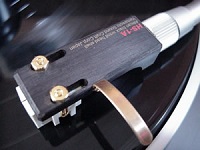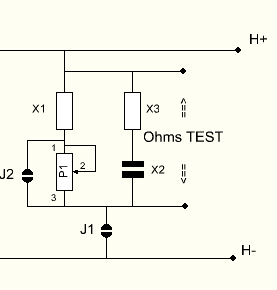Electron Engine ™
Printed Circuit Boards by Emissionlabs ®
EE20 Gold Plated Multi Purpose Board. Version 2.9
- Moving Coil , Applications
 Moving Coil, Tuning (You are here)
Moving Coil, Tuning (You are here)
Tuning a Moving Coil System
Generally, a moving coil system is easy to tune. To begin with, it already works without tuning. It is just to do best justice to the cartridge, or allow the fine tuning which you know is possible, and you want to work your way towards to this. In the end, all it needs is a resistor and a capacitor. So nothing very special to do. In order to prevent difficult searching for the right values, we go here a more comfortable way. On the EE20 board is room for a small potentiometer, which is used to find out what value performs best. So just by listening tests, as this can not be measured anyway. It will be explained in the rest of this text how to do this.
Damping of the cartridge needle
 The needle has quite a tendency to make resonance-like movements by itself. These movements will cause electrical signal, just like any other movement. The result is: the original signal + something additional. This is nothing else but distortion. If below 5%, it can not be heard as such, but it becomes a specific sound still. Which can actually sound nice if, and it's the magic of analog equipment.
The needle has quite a tendency to make resonance-like movements by itself. These movements will cause electrical signal, just like any other movement. The result is: the original signal + something additional. This is nothing else but distortion. If below 5%, it can not be heard as such, but it becomes a specific sound still. Which can actually sound nice if, and it's the magic of analog equipment.
Or, when distortion is too much, or concentrated on a narrow frequency range, the effect is not good. In this case you will get tired from listening to it, even when distortion is not audible as such. In some cases even then needle jumps out of the groove unexpected during a loud music part, but this is rare. Generally, the longer you can listen to a system without getting tired, the better the system is tuned. Often this is not the same as the first impression, or even opposite. Try listening to a soft distorted guitar sound Santana or Mark Knopfler. It sounds nice, but still 15 minutes is enough of this kind of music for me. Whereas with an acoustical guitar, I can hear it much longer before the ear gets tired.
How is the cartridge damping done?
This is done mechanically by the manufacturer already to a large degree. This is a rubber pad, which is pressed between the moving coil itself and the magnet. The rest is done by electrical termination, which is just a resistor, absorbing electrical energy, and it has the same effect, but physically better, and better controlable too. Where is this resistor placed?
To begin with, there is already the standard impedance (47k) of the Phono amplifier, loading the secondary side of the transformer with this value. The transformer ratio will transform this resistor to the cartridge, with the square of the transfer ratio. When the transformer is 1:20, 47k will be changed into 118 Ohms. Or, When the transformer is 1:10, 47k will be changed into 470 Ohms. Now, things automatically begin to fall into place here, because such cartridges which are higher impedance, give more signal, but can step up only a factor 10. Whereas low impedance cartridges have low signal, but can step up a factor 20 easily. For such a low impedance cartridge, 118 Ohms is good, and the high impedance cartridge would prefer a higher value, like 470 ohms indeed. So as said, it falls into place by itself, also because cartridge manufacturers know this.
It there is not enough damping, the needle can move too free, and may also loose groove contact, due to resonance, or too loud music pieces. In bad cases it even jumps out of the groove. If there is too much damping, however, this will also make it too difficult for the needle to move fast, and you loose higher frequencies. Often, the 47k is a good compromise to begin with. Read the note from Roger Modjeski. Effectively, individual damping is always worth a try. What the manufacturer describes as "minimum load" is not "the" load, but is a load you should not go below. In the end, it can only be tried out by experimenting
Example for LL1636
So now everybody would like to send an email about the equipment he uses, and then we have to say the values of the R1, X1, X2, and X3. But this is not how it works.
Suppose we use an ORTOFON SPU:
-Internal impedance: 2 ohm
-Load impedance: >10 ohm
-Output: 0.18mv
Please study this as a calculation example, and when you understood it, you can easily re-calculate this for your own cartridge data.
Let's first see what happens without termination. By using the piano switches, you will soon find out, you need 20x step up, to get the required loudness, without loss of high frequency, and 20x is as high as the LL1636 can go. So the gain is 20x.
Now the minimum load of 100 Ohms transfers into 120 x 10 x 10 = 12k. We take 60% of that, just to hear later what happens at the minimum load, or also below. So this is 7k2, and we take 6k8 because that's easy to find value. For the potentiometer, we recommend a value of 150k. (roughly 3x 47k, of the phono amplifier).

This 6k8 comes now at the position of X1, and with the potentiometer of 150k, we get now a load between 6k8 and 156k. (Leave J2 open). Verify this at the test points, with an Ohms meter. If ok, close Link J1, and now the network is connected in parallel to the secondary side. (H+ and H-).
The potentiometer, you can choose different, we adjust it anyway. After closing J1, this 6k8 or 156k are in parallel to the 47k of the pre amp we already have. So we are now in between 5.9k and 36k, depending on the setting of P1.
The above was calculations. Now comes testing. Try this out, and at some point we come much below the minimum load, and latest then it will not sound good any more. Now, just find the best sounding setting of P1.
- In case you want to add a small capacitor (from 10...100pF) you can put a wire link at the place of X3, and the capacitor comes at X2. Probably this won't be really needed, so begin with a small value if you still want it.
- With the capacitor in, try if P1 needs some adjustment.
- When the setting of P1 is final, you are done.
- Or, when you want to replace the potentiometer by a fixed resistor, go as follows: Open the link J1 and measure at the test points. Select the closest resistor, and place it at the position of X1, and close the link J1, and J2.
- WIth the jumper J1, you can now enable or disable the network, to hear what it does.
* In case you intend to use the dual gain switch, find a setting for P1 which works well on both gain settings. This will normally work out fine, because in the end the whole game is always based on the phone amp impedance of 47k.
In short we can say, with too much damping, the sound becomes dull, and at to little damping the needle looses physical contact with the groove. The ideal damping depends also on the weight of the head shell and stiffness of the tone arm. All of this can not be put in one number. So this is why we recommend variable damping, and switch it on and off, to hear for yourself if there is a difference. Do not regard this something "difficult" with Lundahl transformer, or the EE20 board.. If you think tuning is not needed, you could also skip it.
Note:
This was pointed out to me by my late friend Roger Modjeski, from RAM Labs, USA; An MC cartridge is a coil, moving in a magnetic field. For that reason it is an electric generator. The output voltage depends on the CHANGE of the velocity per time unit. When the coil moves with the same velocity, there is no output signal. So what causes the velocity to change? Well with a frequency range of 20Hz, the velocity of the coil changes 40x from maximum to zero. With 20 kHz, the same is done 20.000 times in one second, so definitely a lot faster, as with 20 Hz. The change of velocity per second is 1000x higher at 20kHz, provided the amplitude is the same, and so the voltage goes up with the frequency. What causes damping? It occurs when the signal generates heat in a load. What causes this energy loss in a resistor is U²xR. But what exactly, causes the coil to generate this energy? It is Friction x path x time. (like power is Watt, and energy is kWh). From the view of the coil, we introduce the Friction with the load resistor. So when an object moves up and down a certain path path 20.000 times in one second, it looses 1000x more energy as when it makes the movement only 20 times. When you understand all of that, it should become clear why higher frequencies gets damped most, by an electric load. Though you would perhaps expect this to require an RC network, this is not so.